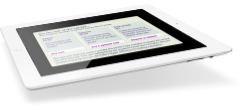Community Embraces New Word Game at Mid-Year Play Day This past Sunday, families at Takoma Park’s Seventh Annual Mid-Year Play Day had the opportunity to experience OtherWordly for the first time. Our educational language game drew curious children and parents to our table throughout the afternoon. Words in Space Several children gathered around our iPads […]
Read moreTag: access

“The debate about which is better, face-to-face learning or online learning is fast becoming obsolete,” says Jennifer Berghage, an instructional designer at Pennsylvania State University. The common goal is that “an online course should be, above all, engaging, so that the learner enjoys the learning and is able to not only assimilate it but retain it and apply it.”
Online courses are revolutionizing formal education, and have opened a new genre of outreach on cultural and scientific topics. These courses deliver a series of lessons to a web browser or mobile device, to be conveniently accessed anytime, anyplace. (more…)
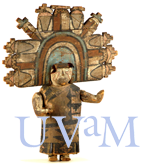 A Hopi doll with painted headdress springs to life, spinning under my finger tips on a new iPad app from the University of Virginia Art Museum (UVaM).
A Hopi doll with painted headdress springs to life, spinning under my finger tips on a new iPad app from the University of Virginia Art Museum (UVaM).
The delightful app presents 19 different objects in 3D, to spin and zoom, providing an immediacy that rivals seeing an object in real life. In fact, it’s better in many ways than peering at an object through a protective case because the objects can be spun through a full 360°, view under bright lighting, at high resolution.
Personal exploration
The free app presents the mobile visitor with a grid of objects (below, left):
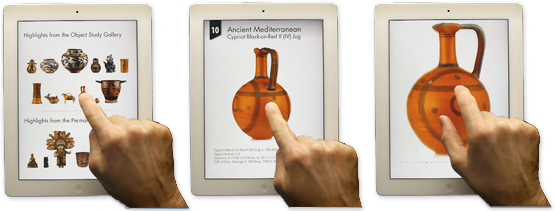
 What was once prohibitively complex and expensive can now be done inexpensively with online testing services. Testing will uncover problems that are confusing for your audience. Here’s a list of vendors to start your research process, and some suggestions.
What was once prohibitively complex and expensive can now be done inexpensively with online testing services. Testing will uncover problems that are confusing for your audience. Here’s a list of vendors to start your research process, and some suggestions.
Three suggestions
For a real-world example on a recent project, designer Ben Snyder said on his blog, “the purpose of the user test is to get feedback about the new design to understand if there are any parts of the website that are confusing to users, and to test the site for hidden bugs that might prevent a user from getting the information they need” or prevent them from completing actions on the site. (more…)
 Make sure your investments on web sites, apps or new real-life programs don’t fail by conducting usability and user experience testing.
Make sure your investments on web sites, apps or new real-life programs don’t fail by conducting usability and user experience testing.
“Usability testing differs from focus groups in that it involves the observation of participants as they actually use the product,” said Ian David Moss, a development consultant who works in the Arts. “They key feature of usability testing that makes it different from most other kinds of feedback-gathering methods is that it is based on direct observation rather than self-reporting….So, rather than have people sit around a room and talk about (for example) how they might react to a new feature or what challenges they face in their daily work, you have people sitting in front of a computer and trying to navigate a website’s capabilities while staff members look over their shoulders and take notes.” (more…)
Smartphones (e.g., the iPhone or Android) are commonplace, and education outreach projects need make use of this reality. People use their smartphones while doing all kinds of things. For example:
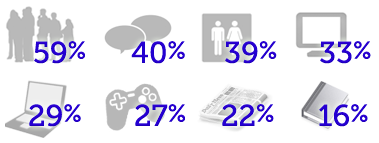
(Left to right, top: while waiting in line, socializing, in the bathroom, while watching TV; bottom: while using a computer, playing video games, reading a paper, or a book.)
The most common place to use a smartphones is at home (93% of smartphone owners), but people use their smartphones all kinds of places: (more…)
Virtual exhibits on tablet devices (e.g., the Apple iPad) put exhibits at the fingertips of students and the public. Visitors can browse science, art or culture from classrooms, during their commutes, or from their sofas. — But where does the money come from?
As with physical museums, the problem with charging money for downloads is limiting visitation to enthusiasts. Access must free to get significant use on tablet computers in classrooms, or by people who would not otherwise pay. Aside from grant support or advertisements, are there other revenue models? Could funding come from the community?
We posit that virtual exhibit apps could be free downloads, giving a preview teaser. Then, to see the rest of the exhibit, visitors pay for access, sponsor access for others, or request free access. Here’s how it might look: (more…)
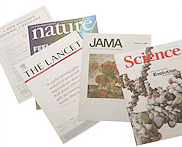 The system of getting knowledge about science to the public is broken. One major crack in the system is a disconnect between science museums and new science research.
The system of getting knowledge about science to the public is broken. One major crack in the system is a disconnect between science museums and new science research.
Science museums matter
Aside from the news media, which now has less science coverage as the journalism business contracts, museums play a vital role in how the public learns about science outside of school. New data show that science museums play an important part in this informal learning.
Despite enthusiastic scientists who are using social media, leading citizen science, and supporting other kinds of outreach, the vast majority of scientific information is ensconced in journals and conferences.
To connect this knowledge to the public, it’s common practice for closed-access journals to give journalists free (advance) access to new articles. But the same courtesy is not provided to science museums that would also benefit from new articles, as well as a back library of older articles. And science museums rarely budget for journal subscriptions. (more…)
 Is the art enough? Probably not. Art museum revenues are falling and museums need to experiment with new business models and ways to build a buzz and relevance with young audiences.
Is the art enough? Probably not. Art museum revenues are falling and museums need to experiment with new business models and ways to build a buzz and relevance with young audiences.
Yesterday, art critic Judith Dobrzynski wrote in her Real Clear Arts blog about how an upcoming nighttime event at the Hirshhorn is elitist, flaunted, and inexcusable. Dobrzynski says, “I’ve said it before, but I’ll say it again, if museum officials don’t believe that art is enough, no one else will either.” What do you think? (more…)


 Metadata is a the glue that makes information useful. It is data about data. It could be a title, location, and camera settings for a photo; the history of a painting; the materials in a museum object; the authors of a journal article; or the time, date, and location of photo of a butterfly for a citizen science project. “Tags” added to blog posts, photos, or tweets are all a form of metadata, allowing others to quickly hone in on related items.
Metadata is a the glue that makes information useful. It is data about data. It could be a title, location, and camera settings for a photo; the history of a painting; the materials in a museum object; the authors of a journal article; or the time, date, and location of photo of a butterfly for a citizen science project. “Tags” added to blog posts, photos, or tweets are all a form of metadata, allowing others to quickly hone in on related items.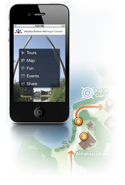 It is getting easier and cheaper for cultural and scientific organizations make mobile, handheld tours. According to
It is getting easier and cheaper for cultural and scientific organizations make mobile, handheld tours. According to 